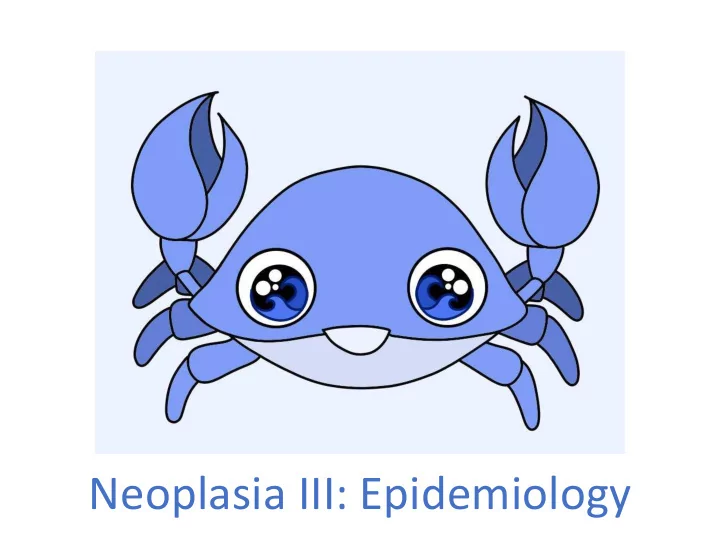

Neoplasia III: Epidemiology
Epidemiology Lecture Objectives • List the most common type of cancer in men and women, and the cancer responsible for the most deaths. • List the seven most important environmental factors that contribute to the development of carcinoma, and describe a little about each one (e.g., types of associated cancers). • Define, compare and contrast the three types of hereditary cancer. • Briefly describe the genetic mutations in Li-Fraumeni syndrome and xeroderma pigmentosum, and explain how they lead to the development of cancer in each disorder.
Epidemiology Lecture Outline • Cancer facts • Environmental factors • Hereditary cancer
Cancer Facts Every year there are: 1.5 million new cases of cancer >500,000 cancer deaths Cancer is the 2 nd leading cause of death (after heart disease) Most common cancers Cancers causing the most deaths Men: Prostate Men: Lung Women: Breast Women: Lung
= 10 per 100,000
Cancer Deaths
Environmental Factors “The single most important environmental factor contributing • Infectious agents to premature death in the US.” HPV Lung, but also oral cavity and • Smoking pancreatic cancers • Alcohol Liver, oral cavity, breast • Diet Colon, prostate, breast estrogen exposure • Obesity “The most overweight people • Reproductive history in the US have over breast and 50% higher death • Environmental carcinogens endometrial cancer rates from cancer” • UV light (skin) • Arsenic (lung, skin) • Asbestos (mesothelioma) • Benzene (leukemia) • Radon (Lung)
Three Types of Hereditary Cancer • Familial cancers • Inherited cancer syndromes • Syndromes of defective DNA repair
Familial Cancers • Most cases of cancer are sporadic (random) • A small number are familial (related to specific germline gene mutations) • Example: certain BRCA1 gene mutations increase risk of breast, colon, ovary, and pancreatic cancers • Familial cancers occur earlier and are more aggressive than their sporadic counterparts
Inherited Cancer Syndromes • Usually autosomal dominant • Each has a specific gene mutation that increases risk of getting multiple cancers • Example: Li-Fraumeni syndrome • mutation in p53 gene • 25x risk of sarcomas, breast cancer, leukemia, and brain tumors • cancers usually appear before age 50
Syndromes of Defective DNA Repair • Inherited mutations in genes encoding DNA repair systems • Greatly enhance the occurrence of mutations in other genes (“genomic instability”) • Example: xeroderma pigmentosum • Mutations in genes in “nucleotide excision repair” pathway (fixes UV-damaged DNA) • Extreme sensitivity to sunlight risk of skin cancer (in childhood!) •
Recommend
More recommend